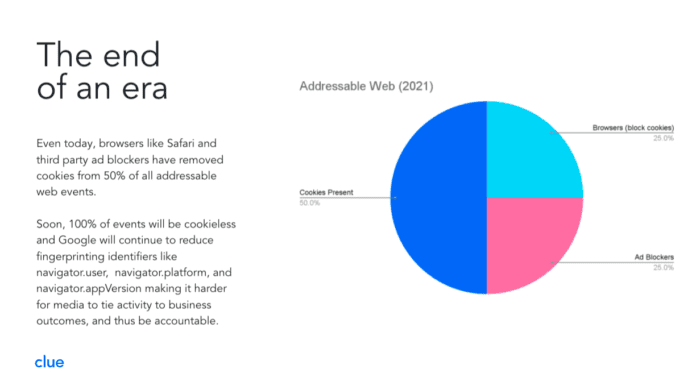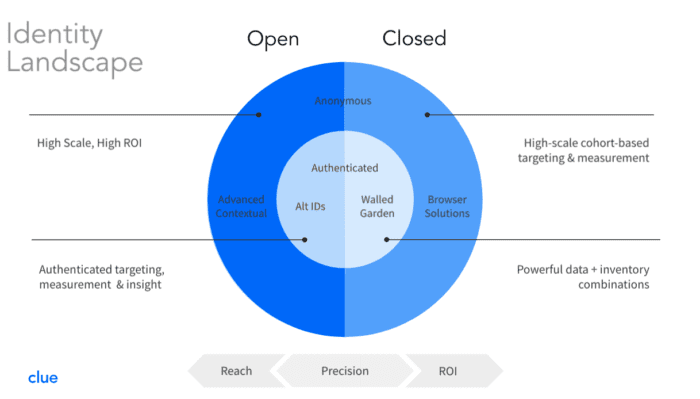Watch (or read the interview below) Josh Alvernia, CEO of Clue, talk about the changing digital landscape in regards to cookies and device IDs and their impact on advertising.
Can you give us a little overview of what Clue is and what you do?
Clue is a performance marketing partner for agencies, like Bloom, as well as brands. The thing that drives everything that we do is this understanding that while when you plan media you focus most on the output (what’s the audience, your targeting, placement, etc.). But, we believe that, in performance marketing, measurement matters as much as media buying.
We build custom solutions for our clients to bridge that gap, so they can have both and drive growth.
The digital landscape is undergoing a major transformation, can you provide a high-level overview of what is happening in the digital space right now?
An easy way to describe what is happening is that we are moving from big data to small and wide. In media buying, there are two types of addressable inventory types: web and app. No matter what media buying platform you’re using, walled garden or open ecosystem, they kind of break up into those two types: cookies for web and device IDs for apps.
What we’re starting to see is that the availability of those types to all people is starting to be closed off. Even in the addressable web today, we only have about 50% of all opportunities available to us. When we look at what’s happening with IDFA across the world with the introduction and rapid adoption of iOS 14.5, app inventory is no longer being provided with an ID. That said, there’s a lot of opportunities here.

When an ID isn’t being provided, the cost of media is being greatly reduced. In large platforms, like Trade Desk, there is a little button you can click that literally says you only want to bid on an inventory that has an ID. That’s a migration that marketers will need to make because it’s no longer going to be massively scalable and it’s incredibly more price efficient.
So what is the landscape going to look like at a later date, well we believe that it’s going to be something like this:

This is a visual that’s actually been shared around the web it wasn’t necessarily created by clue but we think it’s a really good understanding of how the identity landscape is going to look, there are two sides:
- Open, anonymous and authenticated
- Closed, anonymous and authenticated
The Closed Ecosystem
Walled gardens
Walled gardens are what happens when a single entity like Amazon, for example, has both the inventory the audience data side as well as the demand side. Let’s say somebody goes into amazon.com types in a search query. He then clicks through a Display or Search ad on that page. The ad leads to an Amazon listing and he converts.
Because the email ID is logged in through every single point of that journey the entire thing is authenticated, and so advertisers can get what they want which is the full accountability down to return on ad spend.
Browser Solutions
But if you, as a person, were to leave amazon.com and let’s say the advertiser didn’t have a pixel on their site or weren’t able to tie into the ecosystem or deliver to amazon the user ID off of their walled garden they wouldn’t be able to authenticate it. That is where we start to get into the anonymous but closed ecosystem with browser solutions and the SKAD network or Apple’s ecosystem.
Because of the portal that the user interacts with (their apple device or their chrome browser), there is potential that a single entity can follow that activity and it is authenticated to them. But, it is anonymous to the marketer.
The solution is based on the fact that you send them user-level data, you batch thousands of users together because they require you to do so. In the end, they’re just delivering back to you a report:
For example, I had 10 000 people download my app in the last week, how many of these people were also present in my media campaign? The number comes back to you as 2000 because it is grouped together, there is a limitation in terms of what marketers have experienced in the past, where they were able to trace it back to a specific website and calculate ROAS from a single user’s journey from across multiple different ecosystems. Cookies and Device IDs enabled them to do that. Now, it’s starting to become more of an aggregate report which is directional and can provide accountability but it is not the same thing that you experienced before, where it would be applicable to lookalikes audiences in the way that you experienced them before or retargeting in that same way.
The Open Ecosystem
The open ecosystem happens when you are operating with publishers that do not own the exchange and the demand-side They are using the pipes of some other sort of technology provider.
One of the opportunities is alternative IDs: IDs that require a cookie level or an authenticated email.
A good example of alternative IDs is Unified IDs or our partnership with Liveramp. They are able to convert an event that happens if they can authenticate it into a user ID that should be consistent across Connected TV, device ID and cookie IDs. Those should be consistent across a hashed email event allowing you to do the sorts of things that you’ve experienced within a walled garden or within a browser solution like offline attribution or cross-device attribution.
If you really optimize your ecosystem, the target rate in which you can have authenticated IDs could be around 30%. So, that means that 70% of the ecosystem, when you are operating within an open exchange of multiple different publishers offering up their amazing content and inventory, might not come with authenticated IDs.
So what does that mean? What do you no longer have?
Basically everything besides the ID. But, there’s still so much data that could be available to you. We can use automation and algorithmic ways of evaluating the features of a successful ad and optimize those instead of necessarily the user ID.
In the previous insight I showed, CPMs dropping by almost 70% there’s an incredible cost-efficiency. And, at the end of the day, if a user is seeing your ad, that’s still valuable even if the marketer can’t see it or validate their work. The opportunity for the brand to convert somebody and grow their business is still there.
In conclusion, it’s not that accountability in media is gone forever, it is that there is now an incredible fragmentation of ecosystems and you have to operate in each one of them individually with different tactics and different approaches. The IDs that people have come to know (cookies and device IDs) are now fragmenting into many different IDs for specific walled gardens and specific platforms and specific publishers and specific alternative partners.
Now, how do you coordinate all of that’s the true challenge.
But, there are a lot of exciting opportunities in technology today that are coming onto the market and that Clue is excited to lead.
What challenges do advertisers face in regard to privacy regulations or the phasing out of third-party cookies?
When it comes to cookies, it means that the addressable web is being reduced. It becomes harder to validate the effect of a campaign, and it also becomes harder to do things like retargeting, segmentation and lookalike modelling.
Cookies are going to be replaced by many different IDs. Instead of a marketer having one platform be able to use that consistent ID across many different landscapes, all of a sudden, the job of the agency becomes a lot harder, because you have to operate uniquely in many different ecosystems.
I think that it’s an opportunity for agencies because a lot of the concepts around in-housing were happening because of the simplification of the ecosystem. If it becomes fragmented, more complicated third-party services become more valuable, especially in the short term.
When it comes to privacy regulations, one of the major problems is, it’s constantly changing. When it comes to marketers like Clue or agencies that are trying to build unique and independent solutions, it makes it difficult for us.
For brands, it’s a little bit of a different thing. Each geography has its own laws, so if you are an international brand operating in Canada and the States, you have to manage differences in each geography. You need to have things like audit logs, where if you were to be evaluated by a government agency as to whether or not you are following the regulations, you need to show the event in which you collected the data, the consent string in which it happened, how you are utilizing it, whether or not you are transferring it across ecosystems, how all of that is an evolving process.
One of the major challenges today is showing that you’re following privacy regulations and knowing what each geography requires of you.
We’ve seen a few tech giants come out with their solutions to face these challenges, how are you tackling the challenge at Clue?
The major problem today, in addition to segmentation, is attribution – how do you prove the validity of what you’re doing and the return on ad spend that you’re driving for a brand.
So, what Clue has done is :
1. We’ve created a product called Clue Connect, which allows us to manage a client’s first-party data more efficiently.
We’ve noticed that there are generally three data points that are always required in order to do attribution: cookies that come from pixels, device IDs that come from any sort of in-app event and hashed emails that come from a CRM system or POS.
But, if you want to be across all of these different ecosystems, you’re going to be bugging developers a lot. How do you embed one data management platform, or Clue Connect, into a brand so that you integrate only once? So, from there, if the engagement expands to many different platforms and many different approaches, it doesn’t take a lot of strain on a client’s internal development team.
And, you then have the ability to apply a holistic measurement practice that even though now because device ids and cookies are gone, it, at least, allows you to say I’m evaluating the same points inside of my business for every single thing.
2. For programmatic, you don’t have hashed emails. So, we’ve made a partnership with a company called Liveramp which allows us to convert all of those types of IDs into a single ID. With that, we can evaluate the user journey across all of those points.
3. There is a migration that’s happening right now in the analytics space where relational databases and the ability to compare data sets using joins are no longer going to cut it when you move to tens of different ID types. So, we are evangelizing the concept of using graph databases to coordinate all of those things and to map user journeys in places where the connecting points are sometimes unintuitive. In these cases, you need to use things like algorithms to find how things are connected which will eventually lead to probabilistic attribution.
That’s what Facebook is going to start doing, they will make extrapolation where they assume that they’ve had this effect on your campaign. Clue also wants this ability.
What will the industry look like one to two years from now?
What we are already seeing is that all of the players are closing their walls or coming out with their own ID type. There is a couple of Unified IDs that a couple of platforms are jumping in on, but it seems like what marketers are going to deal with is that there’s no longer just going to be two different data points that you got to work (cookie ID and device ID).
There’s now going to be a Unified ID and a Google ID and a Roku ID. There’s either going to be two types of ways that you get data:
- Working in-browser solutions or the SKAD network solution where you send them user-level data and they spit back a report to you. Those reports are not necessarily going to be operable with each other, so marketers will need to coordinate all of those different data points within a singular perspective.
- Building partnerships with some of the larger, more scalable, platforms like Roku or Amazon, is going to be a big opportunity. I don’t think that Google’s browser solution is going to have as much of a punch as they thought, Amazon said that it was going to be blocking FloCs penetration into their ecosystem.
There’s just going to be a massive amount of fragmentation which means that when it comes to solving the analytics and attribution challenge, it’s going to be very complex. That’s why we think a graph database type of infrastructure is going to be so necessary. Everything we want will still be possible, just more fragmented and a lot more complicated, as long as there’s no cooperation happening in the industry.
If you have additional questions about cookies and device IDs, feel free to contact us or visit clue’s website at cluedigital.com.
Subscribe to The Shift Factor
Our newsletter keeps you in the know on marketing’s biggest shifts and real examples of brands adapting.
ABOUT THE AUTHOR
Marie-Joëlle Turgeon
Marie-Joelle works at Bloom, a digital marketing agency, as the Director of Marketing. She's passionate about digital marketing tactics (from social media to web design) for B2B businesses looking to grow online.




Share this: